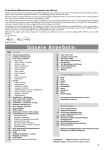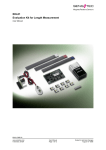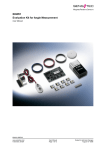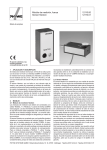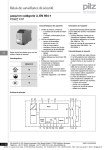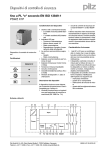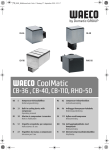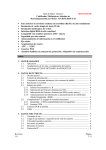Download Light-dependent Control System Operating Instructions Part 1
Transcript
This information is available on the Internet at: www.hansen-neon.de or www.klinger-neon.de L71/04/2008 Contact: Hansen Neon GmbH, Norderstr. 1, 25855 Haselund, Germany, Tel. +49 4843-2009-0, Fax +49 4843-2009-33, E-mail: [email protected] Light-dependent Control System Operating Instructions Part 1 Control Unit Sensor Potentiometer P1 Potentiometer P2 2 m m ) 10 H x x 15 W x Lx 2 ( .5 m Service jumper Ca ble ~1 230 V input Sensor connection 0-10 V output 85 x 85 x 40 mm (L x W x H) Control Elements: - P1 (brightness): potentiometer for setting the dimming level of the LEDs - P2 (switch-off): potentiometer for setting the switch-off response characteristic - Service jumper: for bridging the delay element Technical Data: Uoff = 230 V, 50/60 Hz I on = 0.005 A (~1.2 W) Uoff = 0–10 V (controlled) Sensor Control unit Degree of protection = IP54 230 V Control voltage 0-10 V Wiring: 230 V C100/990 230 V Dimmer 90 W LED Tube with up to 280 LEDs (white) 230 V C100/990 230 V Dimmer 90 W This information is available on the Internet at: www.hansen-neon.de or www.klinger-neon.de L72/04/2008 Contact: Hansen Neon GmbH, Norderstr. 1, 25855 Haselund, Germany, Tel. +49 4843-2009-0, Fax +49 4843-2009-33, E-mail: [email protected] Light-dependent Control System Operating Instructions Part 2 Control Unit Sensor Potentiometer P1 m m 1 0 H) x x 15 W x x 2 2 (L Potentiometer P2 Sensor connection Ca bl e 230 V input ~1 .5 m Service jumper 0-10 V output Functional Description The purpose of the light-dependent control system is to switch and dim an illuminated advertising sign depending on the ambient brightness (twilight switch and dimmer function). Both functions help to reduce the energy consumption and extend the service life of the system. Example: An illuminated advertising sign is switched on at dusk to shine at full brightness. With increasing darkness, the brightness of the system is reduced. At dawn, the brightness of the system is increased again corresponding to the increasing ambient brightness until the sign is finally switched off. Initial Installation First, the converter, dimmer, LEDs and the control unit must be installed and wired as shown in the wiring plan (see part 1 of this instruction). The service jumper in the control unit must be put into the position 1-2 (to deactivate the time delay). The potentiometer P1 is used to set the maximum dimming level at night: Potentiometer P1 turned fully to the right: System is dimmed to approx. 30% Potentiometer P1 in middle position: System is dimmed to approx. 70% Potentiometer P1 turned fully to the left: No dimming The potentiometer P2 is used the set the ambient light level at which the system is switched on and off. The pre-set default is 10 lux. The setting can be changed as follows: Middle position: System is switched on and off at 10 lux Turned to the right: System is switched on earlier (at a lower ambient light level) Turned to the left: System is switched on later (at a higher ambient light level) As the light conditions around illuminated signs can be very different, the switching and dimming levels should be set under real light conditions (i.e. at dusk or dawn). After the setting has been made, the service jumper must be put into the position 2-3 to reactivate the time delay. Additional Information Time delay: The control system is equipped with an internal time delay function to prevent the control system from being influenced by short-time light sources (such as car headlights or lightning flashes). When working on the system, however, the delay can be very inconvenient so that it can be deactivated using the service jumper.


